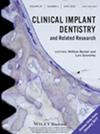Digitally Guided Aspiration Technique for Maxillary Sinus Floor Elevation in the Presence of Cysts: A Case Series
Abstract
Objectives
Sinus floor elevation (SFE) is a widely established surgical procedure for dental implant placement in the atrophic posterior maxilla. However, the presence of maxillary sinus cysts (MSCs) can significantly complicate this intervention. This study presents and evaluates the efficacy and safety of the Digitally Guided Aspiration Technique (DGAT), a novel approach for managing MSCs during SFE procedures.
Materials and Methods
Implant survival and success rates were evaluated according to established criteria, and all complications were systematically documented. Three-dimensional measurements, including MSC volume, residual bone height (BH) surrounding the implants, and apical bone coverage, were obtained using cone beam computed tomography (CBCT). Marginal bone loss (MBL) was assessed through standardized periapical radiographs following prosthetic loading. The accuracy of implant positioning was evaluated by measuring the three-dimensional deviations between virtually planned and actually placed implants. Comprehensive cytological and histological analyses were conducted on aspirated cystic fluid and harvested bone specimens, respectively. Patient-reported outcomes were assessed using questionnaires at the 6-month post-restoration follow-up.
Results
The study comprised seven patients with seven cysts receiving a total of 10 implants. At the 6-month follow-up, the implant survival rate was 100% with no biological or technical complications observed. Volumetric analysis revealed a significant mean reduction in MSC volume of 45.34% ± 33.08% (p = 0.012). Postoperative measurements demonstrated a statistically significant increase in BH compared to baseline values (p < 0.001). This gain remained largely stable throughout the 6-month observation period, with minimal resorption noted in the buccal aspect (p = 0.03) and mean value (p = 0.05). Prior to second-stage surgery, radiographic evaluation confirmed complete bone coverage of all implants, with 60% exhibiting > 2 mm of apical bone coverage. MBL remained within physiological limits. Analysis of implant positioning accuracy showed that coronal global and vertical deviations fell within acceptable clinical parameters, while apical global deviation and angular deviation marginally exceeded recommended thresholds. Cytological analysis of the aspirated cystic fluid revealed no evidence of infection, while histological examination of the regenerated tissue demonstrated mature bone formation with abundant vascularization. Patient-reported outcomes indicated high satisfaction levels.
Conclusions
DGAT can reduce the volume of MSCs, achieve favorable bone grafting and dental implant outcomes with a low incidence of complications. The safety and effectiveness of this procedure need to be compared to the traditional aspiration technique in future randomized controlled trials.
Trial Registration: Chinese Clinical Trial Registry: ChiCTR2400083235. This clinical trial was not registered prior to participant recruitment and randomization

 求助内容:
求助内容: 应助结果提醒方式:
应助结果提醒方式:


